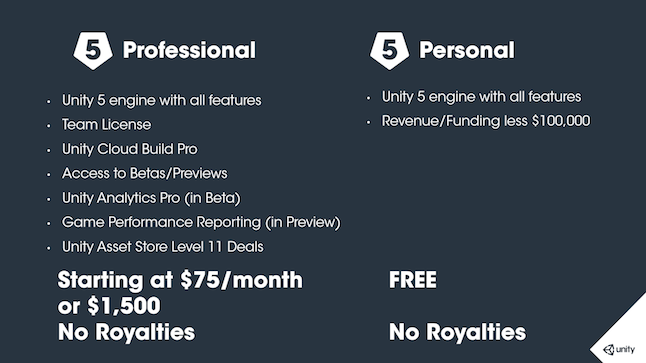“Unity 5 offers an opportunity for graphics. We’re a graphics powerhouse now,” said John Riccitiello as he took to the stage at Unity’s breakfast briefing.
Unity’s CEO began his GDC presentation by highlighting four key improvements. He started by addressing long-standing concerns about the ‘Unity-look’.
“You can make the worlds most beautiful games when you’re building in Unity 5,” he said. And although the audio was missing from the subsequent demo video, he didn’t seem far wrong.
Riccitiello continued by outlining how Unity 5 would open up game development, whether it be through new tools and features, or services like Unity Cloud Build.
“What do we mean by that?” he said. “What we mean is putting tools in the hands of developers, so they can do things more efficiently, more effectively, and faster.”
Riccitiello then gave a top-level overview of the new editor which includes, for the first time, a fully fledged sound mixer built into the game engine. If you are familiar with Pro-Tools and the like, you’ll be right at home.
“There are more features in this editor than you could ever imagine,” he beamed.
But perhaps the most impressive item on the checklist was Unity 5’s impressive multi-platform support.
“When we say multi-platform we actually mean it,” he cried. “21 platforms!”
Unity 5 supports everything from consoles through to mobile and WebGL. It’s fair to say the audience was impressed.
Unity CTO Joachim Ante then took to the stage to look at Unity 5 in more detail.
“Unity 5 is a massive release,” he said. “We have so many new features in it. It’s a game changer for scripting performance. We are debuting it on two platforms. A physics upgrade so you can more stuff, more physical objects on the screen. A 64-bit editor so you can build bigger games, bigger assets. Integrated new audio tools. Animation improvements so you can create intelligent behaviours. We have 57 pages of release notes.”
A recurring aspect during the presentation was ease-of-use and the democratisation of development tools.
“There’s one thing in particular that I’m really proud of,” Ante said. “We tried to build a system where it’s really easy to create beautiful content out of the box – to really make your scenes come to life in a beautiful way.”
To demonstrate Ante introduced a demo built entirely in Unity 5, The Blacksmith. It’s fair to say the audience was impressed again.
The Blacksmith was followed by a closer examination of the Unity 5 editor. Ante focused on how easy it is to position and light assets in realtime. At this point you could see light-bulbs appearing above heads around the room. Everyone was impressed.
Further endorsement came from Camouflaj’s Ryan Payton. Payton showed how Unity 5 was used to port République from mobile to PC.
“I noticed how Unity was equipping small teams like ours, with big team tools.” he said.
“Last summer we started to think seriously about taking the game to PC and Mac, but not just take the game to PC and Mac, not just port it.”
It was the new features in Unity 5 that helped Camouflaj achieve much more than a standard port.
“We love adapting early and new Unity technology, whether it’s the various features in Unity 4, or the Unity Cloud Build service. And when we saw Unity 5, we knew it was exactly what we needed.”
The result for République is a striking upgrade from the original edition of the game. Improvements in art and lighting were evident in every scene and the game looks every bit a Triple-A title.
Unity co-founder David Helgason concluded the presentation with a heart-felt address that displayed genuine emotion at Unity’s achievements.
“Isn’t it wonderful?” he said, visibly proud. “I was watching this and thinking back to the old days and how far we’ve come. And what a big impact we’re having on the industry. It’s really humbling. And the thing I’m most proud of, having been part of Unity for 12 years, is how bloody ambitious we are. How we always push ourselves. And how we have never settled.”
Unity 5’s stated aim is to democratise game development. The evidence was clear throughout the presentation, but no more so than when it came to cost. Unity 5’s pricing starts at $0 for a personal licence, reaching a modest $1500 a month at the top end. It was as clear as statement as any that Unity 5 is aimed at developers of all sizes, from the largest studios, to independents and students.
This impressed everyone.

So what next? The continual democratisation of game development tools is a huge step forward for the industry. I’m sure I wasn’t the only aspiring layman in the audience who thought, “Maybe I could…?”.
Unity 5 will doubtless lead to more developers entering the industry and more games coming to market. But with this growth comes risk. Discoverability of games is hard enough as it is, and Unity 5’s accessibility may lead to a flood of similarly constructed titles. Creating awareness and visibility will be as important as talent.
The biggest take-away from this presentation was that of potential. Unity 5 looks set to reduce much of the friction and pain of development, creating an environment from which new and innovative ideas can flourish and take centre stage.
We should all be impressed with that.






